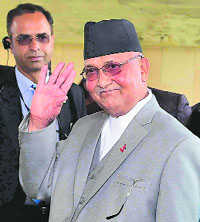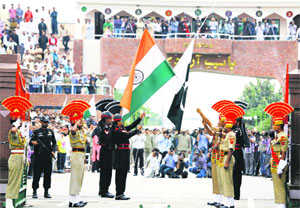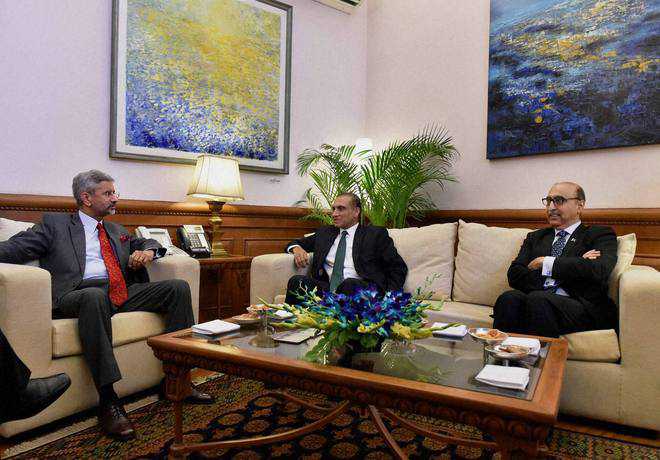Nepal’s ruling K.P. Oli-led Left Alliance is intrinsically pro-China but geography, history and culture make it lean towards India. It’s high time that India leveraged its historic ties with Nepal to curb China’s growing clout in the region and erase the bitterness of last year’s ill-advised blockade
 The Nepalese Prime Minister Khadga Prasad Sharma Oli, after paying tribute at Rajghat, during his recent visit to India. PTI
The Nepalese Prime Minister Khadga Prasad Sharma Oli, after paying tribute at Rajghat, during his recent visit to India. PTIAFTER a week-long trek in the hills around Pokhara, I reached Kathmandu the very day last month Prime Minister KP Oli returned from his visit to China and his Chief of Army Staff, Gen Rajinder Chhetri flew there, the typical political pilgrimage they had done earlier to India that has become mandatory for Nepal to balance its relations with India and China. But it is still India first. Three centuries ago, Nepal’s founding father, king Prithvinarayan Shah had established the equidistance edict. In Hotel Malla, Gopal Thapa, a staff member, asked: “Mr Oli is back from China. Will India impose a blockade again?” This worry is prevalent among many sections of society. The China card has been used by the Royals to guard Nepal’s sovereign space, strategic autonomy and regime security. Its more visible use was noticed after the Maoists rose to power, openly advocating the need to balance India with China and looking beyond India to reduce the overwhelming dependence on its southern neighbour. The ruling Left Alliance government, consisting mainly of Communists and Maoists, is intrinsically pro-China but geography, history and culture make even it lean towards India. Stung by the blockade, the Nepalese hail the 15-point joint statement containing 10 agreements as a diplomatic victory especially the reference to the constitution as historic progress in the transition of Nepal whereas India merely noted its promulgation. The Chinese Ambassador Wu Chuntai had to meet Madhesi leaders who had complained about the iniquities of the constitution lauded in the joint statement. The 10 agreements relate to transit and trade, infrastructure, connectivity including the celebrated ‘One Belt, One Road’ initiative, energy supplies and storage facilities, education, health, tourism — the whole gamut of interactions, exchanges and projects that fill up any joint statement. The transit agreement and feasibility of providing petroleum products are indeed a first but contingent upon connectivity and cost effectiveness. The Lhasa railway has reached Xigatse and is likely to be extended to Gyirong on the Nepal border by 2020. Its further penetration as envisaged in the joint statement to reach Lumbini in Terai is in the realm of the distant future. During a public engagement in Kathmandu on ‘One Belt, One Road’ last year, even as the blockade was in full fury, a young businessman told me that he and his friends were re-routing their business via the North through Hong Kong, instead of the customary southern route. Though long distance, time consuming and costly, the northern transit option is a strategic breakthrough, affording psychological comfort during any future blockade.From an Indian point of view the outcome of the Oli visit is seen high on symbolism and intent: preparation of detailed project reports and feasibility studies but few firm commitments. China has spread its tentacles across the length and breadth of Nepal over the last two decades, utilising its economic wealth to secure political and strategic influence. In 2012, India slipped from the top position in FDI but regained primacy over China in 2015. The competition is likely to continue. Chinese companies enjoy near monopoly in telecommunications and infrastructure sectors. That said, China recognises its lack of human and social capital for people-to-people engagement and its red lines in Nepal. Still it is a challenge India has to meet creatively, with its many leverages and strategic assets in Nepal. The 135-day blockade, which caused unprecedented pain and hardship to ordinary Nepalis, has become part of folklore featuring in songs and films. Hardly anybody in South Block anticipated the anger, alienation and anti-India sentiment it would generate. Many former diplomats would laugh it away saying a blockade has happened before. The 14-month blockade in 1989-90 is as different from the one last year as chalk from cheese. Only with nose and ear to the ground would the PMO have known the lifestyle changes in and outside the Kathmandu valley in the last two decades. In the past, flippant comments by the likes of Madhuri Dixit, Hrithik Roshan and Chief Minister Madan Lal Khurana would create a stir and temporary anti-India sloganeering. So also the Maoists whipping up anti-India hysteria over imagined border encroachments, allegations of India stealing Nepal’s water resources and other engineered indignities inflicted by Big Brother India. The Indian side of the border at most transit points, especially at Sunauli-Bhairahawa, is nothing short of filth and squalor and the road network shoddy for a country with the fastest-growing economy in the world compared to the hugely smart conditions on the Nepali side. That the Birgunj blockade was very successful is partly reflected in the decline in customs revenue there, with corresponding increase in Bhairahawa. Traders fear that Madhesis will restart the protests. The blockade generated a black economy, especially in gas and petrol which has still not normalised completely. Overall, the coercive strategy to secure the constitutional amendments on behalf of the Madhesis and jana jatis was ill thought and has damaged India’s long-term interests in Nepal. Political instability continues to dog Nepal and no post-earthquake reconstruction has begun. New Delhi should help repair the damage done by the blockade by enhancing and fast-tracking its development-assistance programme and imaginatively winning back the hearts and minds of the people, especially the media. The open border and the 1950 Treaty of Peace and Friendship, confer upon the Nepalese unique privileges and facilities in India that no national enjoys in another country. Landlocked Nepal is actually India-opened and provided outlets to sea. Beijing knows it cannot replace India and Nepal and therefore, does not give false hopes to Kathmandu. What Nepal really needs now, as championed by the diminished Maoist leader Prachanda, is a National Unity government. While Oli has to keep his promise of addressing the Madhesis’s residual constitutional issues, Prime Minister Modi will need to revisit Pashupatinath. The writer, a retired Major-General from the Gorkha Regiment, has been visiting Nepal since 1959.







































































